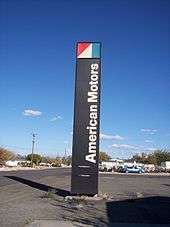AMC straight-6 engine
The American Motors Corporation (AMC) straight-6 family of engines was used in AMC passenger cars and Jeep vehicles from 1964 through 2006.
195.6
American Motors' first straight-six engine was the 195.6 cu in (3.2 L). It was produced from 1952 through 1965 in both overhead valve (OHV) and flathead (L-head) side-valve versions.
Sometimes referred to as the 196 engine, this engine was originally designed by Nash and introduced in the 1941 Nash Ambassador 600 model. It featured only four main bearings, unlike the 7-main-bearing 234 flathead engine it replaced. It was a flathead design displacing 172.6 cu in (2.8 L). It was later enlarged to 184 cu in (3.0 L), and finally to 195.6 cu in (3.2 L). It was redesigned as an OHV engine in 1956. The flathead version was discontinued for 1956–1957, but reemerged in 1958 as the economy engine for the "new" Rambler American. When the engine was changed to an OHV configuration the water pump was moved from the left side of the engine (driven by a shaft extending from the back of the generator) to the front above the timing chain. When the flathead model was reintroduced it also received the new water pump. Equipped with such high quality parts as forged crankshafts and connecting rods, these engines earned a reputation for remarkable durability. The flathead, however, was prone to the typical flathead problem of overheating under sustained heavy load. This was from the hot exhaust traveling through the cylinder block to the exhaust manifold.
American Motors introduced a die-cast aluminum block version of the OHV 195.6 cu in (3.2 L) engine in 1961. It was produced through 1964. This engine used cast-iron cylinder liners and a cast-iron head. The cylinder heads for the two types of block (aluminum and cast iron) are of similar design, but are not interchangeable. The cylinder head for the aluminum block is roughly 1/8" wider than that for the cast iron block and uses a slightly different head bolt pattern.[1]
The 196 OHV requires more periodic maintenance than newer-model engines. The head bolts must be re-torqued (retightening process) regularly. Factory service manuals recommend that head bolt torque be checked every 4,000 mi (6,400 km) and to re-torque them every 8,000 mi (13,000 km). With modern head gaskets this service interval can be extended to re-torque the bolts every 12,000 mi (19,000 km), or every other year. The cause of the headbolts loosening over time is believed to be thermal expansion and contraction of the head due to the rather heavy design. The head expands and contracts by as much as 0.020" in height during normal operation, this loosens the bolts over time and eventually will cause the seal between head and block to fail. This maintenance is also imperative to prevent the engine from overheating (the first sign of a blown head gasket) and warping or cracking the head. The cast-iron liners in the aluminum block version can also shift if the head bolts are not properly torqued and the engine is allowed to overheat. Good replacement heads and aluminum blocks for these engines are now difficult to find.
The modern era I-6

The company designed an entirely new six-cylinder with a short stroke and seven main bearing crankshaft for 1964. This design was produced in various forms through 2006. The 232 cu in (3.8 L) "Torque Command" inline six was AMC's first modern six-cylinder engine.[2]
To commemorate the engine's May 1964 introduction, 2,520 "Typhoon" cars were made on the Rambler Classic hardtop body.[3] Each featured the 145 hp (108 kW; 147 PS) 8.5:1 compression ratio engine, Solar Yellow body paint, a Classic Black roof, and a distinctive "Typhoon" script in place of the usual "Classic" name. All other AMC options (except engine options) were available.[4]
The new engine replaced the Nash 195.6 cu in (3.2 L) OHV I6 in the Classic and Ambassador for the 1965 model year (this was also the first use of a six in the Ambassador since 1956).
In 1966, a 199 cu in (3.3 L) version finally replaced the aging 195.6 cu in (3.2 L) OHV and L-head engines. Road tests by Consumer Reports described the new powerplant as "a very smooth and quiet engine, which should give good performance."[5]
Both the 199 and 232 featured a 3.75 in (95 mm) bore, and either a 3.0 in (76 mm) or 3.5 in (89 mm) stroke. The 199 was discontinued in 1970; the 232 was offered alongside the 258 cu in (4.2 L) (made by using a 3.895 in (98.9 mm) stroke crankshaft and slightly taller block) during the 1970s, but was discontinued in 1979. Increasingly stringent emission control regulations continued to decrease the engine's power output, making the smaller version inadequate as increasingly stringent safety regulations also made vehicles heavier.
199
The 199 cu in (3.3 L) (198.8 cuin / 3,258 cc) 199 was produced from 1965 to 1970.
Applications:
- Rambler Classic (1965–66, fleet cars only)
- Rambler American/AMC Rambler (1965–69)
- AMC Hornet (1970)
- AMC Gremlin (1970)
- VAM Rambler American (mid 1965–1969) U.S. equivalent - AMC Rambler American and AMC Rambler sedans.
- VAM Camioneta Rambler American (mid 1965-1967) U.S. equivalent - AMC Rambler American wagon.
232
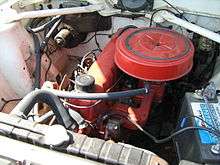
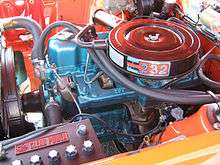
The 232 cu in (3.8 L) (231.9 cu in / 3,801 cc) 232 was produced from 1964 to 1979. The 232 was the base six-cylinder engine on many models through 1979, and even towards the end of its usage was considered reasonably modern in design.[6]
After its midyear 1964 introduction in the "Typhoon" two-door hardtop as part of the mid-sized Rambler Classic line, the 232 engine was adapted to fit into the smaller 1965 Rambler American by using a special short water pump, an adaptive piece also used in the 1971–1975 Jeep CJ-5.[7] Air conditioning was available only with the older 196 engine in the American, because there wasn't space for it with the longer 232.[7]
Through the 1970 model year, the 232 shared a deck height with the 199 cu in (3.3 L) engines. Starting in 1971, AMC raised the deck height to produce the 258, and the 232 adopted the 199's longer connecting rods and shared deck height with the 258. Bore and stroke remained the same.
In 1972, the bell housing bolt pattern changed to match the larger version used on the V8 engines.[7]
Changes for the 1976 model year included fuel economy improvements that also reduced emissions and reduced warmup time.[8] This was accomplished by reshaped carburetor air passages that pushed the fuel efficiency of a 232-equipped AMC Gremlin to 30 mpg-US (7.8 L/100 km; 36 mpg-imp) as tested by the United States Environmental Protection Agency, compared to 24 mpg-US (9.8 L/100 km; 29 mpg-imp) in 1975.[8]
Applications:
- Rambler Classic (1964–1966)
- Rambler American/AMC Rambler (1964–1969)
- Rambler/AMC Marlin (1965–1967)
- Rambler/AMC Ambassador (1965–1970)
- Rambler/AMC Rebel (1967–70)
- AMC Javelin (1968–74)
- AMC Hornet (1970–77)
- AMC Gremlin (1970–78)
- AMC Matador (1971–74)
- AMC Pacer (1975–79)
- AMC Concord (1978–79)
- AMC Spirit (1979)
- Jeep CJ (1972–79)
- Jeep Cherokee (1974–79)
- Jeep Wagoneer (1965–1971)
- Jeep J-Series (1965–1970)
- Jeep Commando (1972–1973) (1976 in Spain)[9]
- International Harvester Scout (1969–1971)
- International Harvester Light Line pickups/Travelall (1968–71)
- VAM Rambler American Hardtop (1965) U.S. equivalent AMC Rambler American 440H hardtop
- VAM Rambler American Rally (1969-1971) U.S. equivalent 1969 AMC Rambler Rogue sedan instead of hardtop and 1970-1971 Hornet X
- VAM Rambler American (1968-1972) U.S. equivalent AMC Rambler American sedans and AMC Hornet sedans
- VAM Camioneta Rambler American (1968-1972) U.S. equivalent AMC Rambler American wagon and AMC Hornet Sportabout
- VAM Rambler Classic 660 (1965) U.S. equivalent AMC Rambler Classic
- VAM Rambler Classic 770 (1966-1969) U.S. equivalent 1966 AMC Rambler Classic sedans plus AMC Rebel four door sedan
- VAM Rambler Classic SST (1967-1969) U.S. equivalent AMC Rebel hardtop
- VAM Javelin (1968-1969) U.S. equivalent AMC Javelin
- VAM Gremlin (1974-1976) U.S. equivalent AMC Gremlin
252
The 252 cu in (4.1 L) engine was produced by AMC's Mexican subsidiary Vehiculos Automotores Mexicanos (VAM) beginning in 1969 and was dropped after 1972, replaced with AMC's 258 for the 1973 model year onward. This was similar to a 232 in stroke with a larger 3.91 in (99 mm) bore, for an actual displacement of 252.15 cu in (4,132.0 cc).
Output for 1972 Rambler American Rally model (gross):
Engine dimensions:
- Compression ratio 9.5:1
- Intake valve diameter 2.020 in (51.3 mm)
- Exhaust valve diameter 1.6755 in (42.56 mm)
- Pushrod length 5.875 in (149.2 mm)
- Deck height 9.424 in (239.4 mm)
- Bore 3.910 in (99.3 mm)
- Stroke 3.50 in (89 mm)
Applications:
- VAM Javelin (1969-1970) U.S. equivalent - AMC Javelin
- VAM Rambler Classic SST (1969-1971) U.S. equivalent - AMC Rebel hardtop and AMC Matador hardtop
- VAM Rambler Classic 770 (1970) U.S. equivalent - AMC Rebel sedan
- VAM Rambler Classic DPL (1971) U.S. equivalent - AMC Matador sedan
- VAM Rambler American Rally (1972) U.S. equivalent - AMC Hornet Rallye X
258
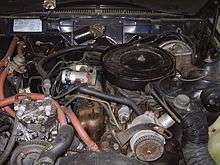
The 258 cu in (4.2 L) was produced from 1971 to 1990. It featured an undersquare 3.75 in (95 mm) bore and 3.895 in (98.9 mm) stroke; it was otherwise similar to the 199 and 232. This engine is considered reliable, inexpensive, and torquey.[10] Later 258 models (starting with the 1980 model year for California AMC Concords and Spirits, 1981 for California Jeeps, California Eagles, and 49-state Concord and Spirits, as well as in 1982 for 49-state Eagles and all other applications) are equipped with AMC Computerized Engine Control (CEC) system. For 1981, as part of a weight reduction program (aluminum intake manifold, plastic rocker arm cover), the crankshaft was changed from a twelve counterweight design to four, saving approximately 20 pounds. This engine also found some use in farm/industrial applications such as the International Harvester 4000 swather.
Applications:
- AMC Hornet/Concord/Eagle (1971–1988)
- AMC Pacer (1975–1980)
- AMC Matador (1971–1978)
- AMC Gremlin and Spirit (1971–1983)
- International Harvester Scout and Light Line trucks (1972–1980)
- Jeep CJ (1972–1986)
- Jeep Cherokee and Wagoneer (1972–1986)
- Jeep J-Series (1971–1988)
- Jeep Wrangler (1987–1990)
- Jeep Commando (1972–1973)
- VAM Rambler American (1973–1974) U.S. equivalent - AMC Hornet sedans
- VAM Rambler American Rally (1973–1974) U.S. equivalent - AMC Hornet X sedan instead of hatchback.
- VAM Camioneta Rambler American (1973-1974) U.S. equivalent - AMC Hornet Sportabout
- VAM American (1975–1983) U.S. equivalent - AMC Hornet sedan base model and AMC Concord sedan base model.
- VAM American Rally (1975) U.S. equivalent - AMC Hornet X sedan instead of hatchback.
- VAM Camioneta American (1975-1983) U.S. equivalent - AMC Hornet Sportabout and Concord base model wagon.
- VAM American ECD (1975–1979) U.S. equivalent - AMC Hornet DL two and four door sedans and AMC Concord DL/Limited four door sedan.
- VAM Gremlin X (1976–1982) U.S. equivalent - AMC Gremlin X and AMC Spirit sedan X model equivalent.
- VAM Gremlin (1977–1983) U.S. equivalent - AMC Gremlin and AMC Spirit sedan base model.
282
The 282 cu in (4.6 L) engine was produced by AMC's Mexican subsidiary Vehiculos Automotores Mexicanos (VAM) beginning in 1971 through 1986. This was similar to a 258 in stroke, cast with a larger 3.917 in (99.5 mm) bore, 0.16" larger than the 258, giving 281.7 cu in (4,616 cc).[11]
Output for 1971-73 models (gross):
- Horsepower 200 hp (149 kW; 203 PS) @ 4400 rpm
- Torque 280 lb·ft (380 N·m) @ 2200 rpm
- Compression ratio 9.5:1
Output for 1974 models (gross):
- Horsepower 200 hp (149 kW; 203 PS) @ 4400 rpm
- Torque 280 lb·ft (380 N·m) @ 2200 rpm
- Compression ratio 8.5:1
Output for 1975-76 models (gross):
- Horsepower 200 hp (149 kW; 203 PS) @ 4400 rpm
- Torque 280 lb·ft (380 N·m) @ 2200 rpm
- Compression ratio 7.7:1
Output for 1977-78 models (gross):
- Horsepower 200 hp (149 kW; 203 PS) @ 4400 rpm
- Torque 280 lb·ft (380 N·m) @ 2200 rpm
- Compression ratio 8:1
Output for 1979-81 Standard models (net):
- Horsepower 132 hp (98 kW; 134 PS) @ 3800 rpm
- Torque 216 lb·ft (293 N·m) @ 2200 rpm
- Compression ratio 8:1
Output for 1979 American 06/S and 1980-81 Rally GT models (net):
- Horsepower 172 hp (128 kW; 174 PS) @ 4200 rpm
- Torque 225 lb·ft (305 N·m) @ 2600 rpm
- Compression ratio 8.5:1
Output for 1982-83 models (net):
- Horsepower 129 hp (96 kW; 131 PS) @ 4000 rpm
- Torque 218 lb·ft (296 N·m) @ 1800 rpm
- Compression ratio 8.5:1
Engine dimensions:
- Intake valve diameter 2.020 in (51.3 mm)
- Exhaust valve diameter 1.6755 in (42.56 mm)
- Connecting rod length 5.875 in (149.2 mm)
- Deck height 9.424 in (239.4 mm)
- Bore 3.917 in (99.5 mm)
- Stroke 3.895 in (98.9 mm)
Applications:
- VAM Javelin (1971-1973) U.S. equivalent - AMC Javelin
- VAM Classic DPL (1972-1976) U.S. equivalent - AMC Matador Sedan
- VAM Classic Brougham (1972, 1974-1976) U.S. equivalent - 1972 AMC Matador hardtop and AMC Matador Brougham coupe
- VAM Classic AMX (1974-1976) U.S. equivalent - AMC Matador X coupe
- VAM Pacer (1976-1979) U.S. equivalent - AMC Pacer coupe
- VAM Pacer X (1979) U.S. equivalent - AMC Pacer X coupe
- VAM American Rally (1976-1977) U.S. equivalent - AMC Hornet X sedan instead of hatchback
- VAM American Rally AMX (1978-1979) U.S. equivalent - AMC Concord AMX hatchback
- VAM American GFS (1977-1982) U.S. equivalent - AMC Hornet DL two-door sedan plus AMC Concord DL and Limited two-door sedans
- VAM Camioneta American Automática (1977-1978) U.S. equivalent - AMC Hornet DL wagon and AMC Concord DL wagon, both with automatic transmission
- VAM Camioneta American DL (1979-1983) U.S. equivalent - AMC Concord DL and Limited wagons
- VAM American 06/S (1979) U.S. equivalent AMC Concord two-door sedan, high-performance limited edition
- VAM American ECD (1980-1982) U.S. equivalent - AMC Concord DL and Limited four-door sedans
- VAM Rally AMX (1980-1983) U.S. equivalent - AMC Spirit GT coupe, standard version
- VAM Rally GT (1980-1981) U.S. equivalent - AMC Spirit GT coupe, high-performance version
- VAM Rally SST (1981) U.S. equivalent - AMC Spirit Limited coupe
- VAM Lerma (1981-1982)
- VAM Jeep Wagoneer (1972-1983) U.S. equivalent - AMC Jeep Wagoneer
- Renault/VAM Jeep Grand Wagoneer from 1984 through 1986 (U.S. equivalent - Jeep Grand Wagoneer)
The 282 which had a larger bore is considered the ancestor of the 4.0 stroker engine where it is common for the engine rebuilder to use an AMC 258 crankshaft in a Jeep 4.0 cylinder block - a 4.5 uses the stock AMC 258 connecting rods (with a stock or .020 overbore using aftermarket pistons) while the 4.6, 4.7, and 5.0 strokers use the 258 crank but retaining the 4.0 connecting rods.
4.0

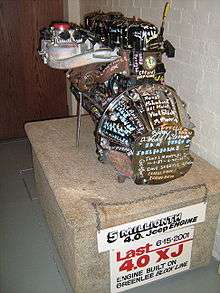
The 242 cu in (4 L) engine was developed by AMC in just 26 months using many off the shelf components while featuring, among others, additional strength, improved combustion chamber, port setup, and cam profile.[12] The total weight of the new engine was 483 pounds (219.1 kg), only one pound more than the 258 six despite its heavier components and parts.[12] For example, the cast aluminum valve cover featured 15 bolts, the industry's most, to achieve a positive seal.[12]
The new engine, which was introduced in 1986 for the 1987 model year, was a further evolution of AMC's 258 six.[13] It had a 3.875 in (98.4 mm) bore and a 3.414 in (86.7 mm) stroke giving it a displacement of 241.6 cu in (3,959 cc).[14] Connecting rod length was 6.125" - similar to the discontinued 199 which was phased out in 1970.
The 4.0 is one of AMC's best-known engines.[15] It was one of four AMC engines kept in production when Chrysler bought AMC in 1987. Chrysler engineers continued to refine the engine to reduce noise, vibration, and harshness. The last in the line of the AMC inline sixes, the 4.0 is regarded as one of the best Chrysler 4x4 off-road engines.[16] A Motor Trend long-term test of a 1997 Cherokee XJ noted "this long-lived OHV powerplant has a reputation for getting people where they need to go" as well as "much love expressed by owners for the torquey 4.0-liter/190-horsepower inline six."[17] The engine is known for longevity, and can sometimes go more than 300,000 miles (482,803 km) without rebuilding.[18][19] There are many aftermarket parts available.[20]
When introduced, the block-mounted oil filter check valve was eliminated on the 4.0 (along with the 2.5 and 4.2s manufactured after September 1986) when AMC engineers standardized their oil filters. The pre-1987 engines had an oil filter adapter with 3/4 (cylinder block end) and 13/16 threads (which used a GM oil filter common to Buick, Oldsmobile, Pontiac, and Cadillac V8 engines) while the 1987-06 engines were originally fitted with a 20 mm metric thread filter (later revised in 1991 for the common 3/4 threaded Mopar and Ford V8 oil filter; the oil filter adapter was redesigned where the oil filter is positioned 90 degrees offset adjacent to the starter motor - a Ford V8 oil filter can be used in place of the short filter increasing oiling capacity).
The first 4.0 engines in 1987 had a RENIX (Renault/Bendix) engine management system considered quite advanced for their time.[10] A knock sensor allowed the ECU to control spark advance in response to fuel octane and engine load. Unfortunately, there are few scan tools capable of interfacing with the system to pull diagnostics codes. RENIX systems also have no permanent memory for diagnostics codes thus making the diagnosis of intermittent problems more difficult.[21]
The 1987 RENIX 4.0 made 173 hp (129 kW; 175 PS) and 220 lb·ft (300 N·m). In 1988, the 4.0 received higher flowing fuel injectors, raising output to 177 hp (132 kW; 179 PS) and 224 lb·ft (304 N·m)—more power than some configurations of the Ford 302, Chevrolet 305, and Chrysler 318 8-cylinder engines, and more than any of the Japanese 6-cylinder truck engines, but with comparable or superior fuel economy.[21]
In 1991, a Chrysler MPI fuel injection system replaced the RENIX system, and the intake ports were raised approximately .125 in (3.2 mm) for a better entry radius. Chrysler also enlarged the throttle body and redesigned the intake and exhaust manifolds for more efficiency, and the fuel injectors were replaced with higher flow units. Camshaft timing was also changed. The net result was an engine that made 190 hp (142 kW; 193 PS) and 225 lb·ft (305 N·m). Badging on most Jeeps equipped with this engine read "4.0 Litre HIGH OUTPUT." The new cam profile combined with altered computer programming eliminated the need for an EGR valve and knock sensor, but made the engine more sensitive to alterations, especially where emissions are concerned. The OEM fuel injectors used with the Mopar MPI system (manufactured by Siemens) have been known to leak fuel especially with OBDII where plugged catalytic converters are common which usually throws a P0420 code.
Small changes were made to the cylinder head for the 1995 model year. In 1996, the engine block was redesigned for greater strength. The new block had more webbing and a stud girdle for added rigidity of the crankshaft main bearings. Engines installed in 1999 Grand Cherokees carried the "PowerTech" name that had been used intermittently in prior years and on other Chrysler truck and SUV engines. The name was subsequently passed on to 4.0s in the other Jeep models that used the engine, the Cherokee and Wrangler. The cylinder head was again changed for the 2000 model year to a more emissions-friendly design. This head was designated as "0331" in the casting number. Early 0331 heads are prone to cracking, causing coolant to contaminate the oil, which can lead to catastrophic engine failure. The head cracks in the center between #3 and #4 cylinders. The crack is usually discernible with the valve cover removed as a "milky" tan line. This condition is usually discovered before catastrophic engine failure, but can lead there if not corrected in a timely manner. The casting was fixed in mid to late 2001, but the same casting number was retained. The "fixed" heads have "TUPY" cast in the center where the cracks used to occur.[22] Also new for the 2000 model year, was the distributorless, coil on plug ignition system.[23] Option code: ERH.
Output:[24]
- 1987-90: 177 hp (132 kW; 179 PS) at 4500 rpm and 224 lb·ft (304 N·m) at 2500 rpm
- 1991-95: 190 hp (142 kW; 193 PS) at 4750 rpm and 225 lb·ft (305 N·m) at 4000 rpm
- 1996-01: 190 hp (142 kW; 193 PS) at 4600 rpm and 225 lb·ft (305 N·m) at 3000 rpm
- 2001-06: 190 hp (142 kW; 193 PS) at 4600 rpm and 235 lb·ft (319 N·m) at 3200 rpm
The 4.0 engine was discontinued at the end of the 2006 model year, replaced in the redesigned 2007 JK Jeep Wrangler by Chrysler's 3.8 L OHV V6, which originated in the company's minivans. The 4.0 engine was also made in China, where a slightly modified version of the XJ Jeep Cherokee with 2.5 and 4.0 engines were produced alongside the Chinese-produced WJ Grand Cherokee since 2006.
This engine was used in the following vehicles:
- 1987–2001 Jeep Cherokee
- 1993–2004 Jeep Grand Cherokee
- 1987–1990 Jeep Wagoneer
- 1987–1992 Jeep Comanche
- 1991–2006 Jeep Wrangler
Connecting Rod lengths
1964-1970:
- 199 CID (3.3 L) - 6.125 in (155.6 mm)
- 232 CID (3.8 L) - 5.875 in (149.2 mm)
- 252 CID (4.1 L) - 5.875 in (149.2 mm)
1971–2006:
- 232 CID (3.8 L) - 6.125 in (155.6 mm)
- 242 CID (4.0 L) - 6.125 in (155.6 mm)
- 258 CID (4.2 L) - 5.875 in (149.2 mm)
- 282 CID (4.6 L) - 5.875 in (149.2 mm)
- The displacement differs between 1990 and 1995 and 1996–2006 4.0L engines by 2 cubic inches. Both had a bore of 3.875 in (98.4 mm), while the stroke decreased slightly from 3.4375 inches (87.31 mm) on the earlier engine to 3.414 inches (86.72 mm) on 1996 and later engines. The displacement of both engines still rounds to 4.0 litres (3999.83 cc v. 3964.95 cc). The small stroke change (0.03"/0.77mm) was accomplished by moving the piston pin and changing the crankshaft stroke, rods are the same.
The deck height of the AMC six cylinder block was increased by 0.125 inches (3.18 mm) (half the rod length difference) in 1971 to allow for the longer stroke required for the 258. Only two deck heights. Tall deck is 9.528-9.534". Short should be 9.278-9.284". Tall is from a 74-76 AMC factory service manuals, prior to 1974 deck height was not printed. Deck height changed slightly over the years 1977-1982 service manuals state 9.487-9.493", the 1993 Jeep factory manual states 9.429-9.435". Deck heights may have changed to accommodate slightly different compression ratios over the years.[25]
The 1971 and older blocks use a "small" bell housing bolt pattern that is exclusive to AMC and small Nash sixes. In 1972 the bell housing bolt pattern was changed to match the AMC V8's - its final use was in 2006 when the 4.0 was phased out. Four bolts on the cylinder block are matched to the transmission bellhousing where an adapter plate serves both as a dust cover - two additional bolt holes on the transmission bellhousing used on the AMC V8 are used to secure the dust cover. The 1971 258 uses the "small" pattern, the only year 258 to do so.
See also
References
- ↑ 1950-1965 Nash/AMC Technical Service Manuals
- ↑ Potter, David V. (June 1964). The new Rambler six engine: torque command 232 (SAE 884B). Society of Automotive Engineers.
- ↑ "Rambler blows in with Typhoon". Popular Science. 184 (6): 66. June 1964. Retrieved 26 November 2010.
- ↑ Auto Editors of Consumer Guide (15 June 2007). "How Rambler Cars Work: 1963, 1964 Rambler Cars". auto.howstuffworks.com. Retrieved 22 June 2010.
- ↑ "The 1965 Cars". Consumer Reports. 30: 198.
- ↑ Chilton's Automotives Editorial (1987). Chilton's Auto Repair Manual 1982. Chilton Book Company. ISBN 978-0-8019-7052-8.
- 1 2 3 mhaas (17 January 2006). "1964-65 American". amcyclopedia.org. Retrieved 17 August 2012.
- 1 2 Dunne, Jim (October 1975). "How American Motors does it". Popular Science. 207 (4): 117. Retrieved 12 December 2010.
- ↑ Lamm, Michael (November 1976). "Old cars never die ... they show up in foreign lands". Popular Mechanics. 146 (5): 160. Retrieved 26 August 2012.
- 1 2 "AMC 258 I6". offroaders. Retrieved 26 November 2010.
- ↑ Thomas. "Mexican AMC 6 Cyl. Engine Info". Archived from the original on 29 May 2013. Retrieved 26 November 2010.
- 1 2 3 Warren, Pete (October 1986). "Technical Highlights: American Motors". Popular Mechanics. 163 (10): 145. Retrieved 17 April 2013.
- ↑ Tellem, Tori (April 2006). "Jeeps Kick Ass Engine - The History Of The 4.0 L". Jp Magazine. Retrieved 17 April 2013.
- ↑ "XJ 4.0 L". Service Manual 2000 Jeep Cherokee. DiamlerChrysler. 2000. p. 115.
bore x stroke = 3.875 x 3.414 inches
- ↑ Allen, Jim (2003). Jeep: Collector's Library. MBI Publishing. p. 178. ISBN 978-0-7603-1486-9.
- ↑ Worthy, Willie (January 2009). "Jeep Motors History - Willies Workbench: Jeep Engines De-Mystified". Four Wheeler. Retrieved 17 April 2013.
- ↑ Bartlett, Jeff; Lorentzen, Randy (March 1999). "Road Test: '97 Jeep Cherokee - Long-Term Wrap-Up". Motor Trend. Retrieved 17 April 2013.
- ↑ "cherokee longevity". JeepCherokeeForum.com. Retrieved 24 May 2012.
- ↑ "Longevity Questions. 4.0 WJ owners, how many miles?". Jeeps Unlimited. Retrieved 24 May 2012.
- ↑ "Jeep Performance Parts and Products". rustysoffroad.com. Retrieved 17 August 2012.
- 1 2 Stern, Peter. "The Jeep 4.0 liter PowerTech Straight-Six Engine". allpar.com. Retrieved 17 April 2013.
- ↑ "'00-'01 XJ Cracked Cylinder Head (OVERVIEW)". cherokeeforum.com. Retrieved 17 August 2012.
- ↑ "Pre-EFI Jeep Inline Six-Cylinder Ignition Upgrades" (PDF). 4wdmechanix.com. Retrieved 17 August 2012.
- ↑ "Used Jeep Models". edmunds.com. Retrieved 17 August 2012.
- ↑ 1974 ANC Technical Service Manual. Group 1A, Six-Cylinder Engines: American Motors Corporation. 1974. pp. 1A–31.
External links
| Wikimedia Commons has media related to AMC straight-6 engine. |
- Allpar's 4.0 page
- AMC Rambler Club—Club for 1958 - 1969 AMCs
- American Motors Owners—Club for 1958 - 1987 AMCs
